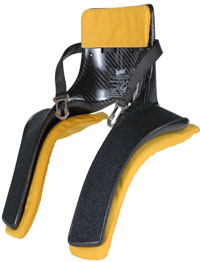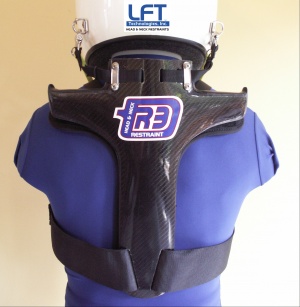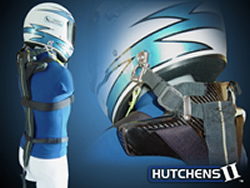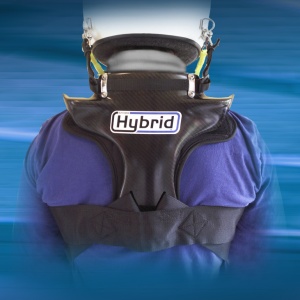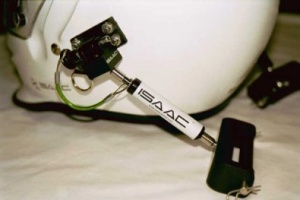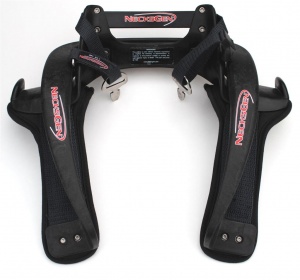Head and Neck RestraintsFrom TrackpediaThis page has critical content Trackpedia would like to see the main page remain as product neutral as possible with the focus more on defining and explaining what a Head and Neck Restraint system is and why they are beneficial. If there are product specific items that contributors wish to add please place them on the page for the specific product. Thanks - John The Head and Neck Restraints Wiki is bought to you by SafeDrives for all your H&N needs check out http://www.safedrives.com
Head and Neck restraintsA Head & Neck Restraint (H&NR) is basically an extension to your helmet which protects your neck in a collision. It lowers the strain on your neck to a level that hopefully avoids a basilar skull fracture. Once you secure your body in a car with a harness then your head is still 'floating' and unrestrained (except by your neck!). You are also wearing a helmet which adds mass to the already substantial mass of your head. Given the body is restrained by harnesses and your head is only restrained by your neck then the neck will have a serious load placed on it in a front or side impact. Remember, your harnesses need to support 3000lbs of force. Your neck can't do that. A Head and Neck restraint is designed to absorb that energy so the neck load is reduced substantially. An estimated 50% of racing deaths are caused by basilar skull fractures. The Isaac devices manufacturer claims that this type of injury occurs at 4000 newtons or 900 pounds of force on your neck. All certified H&NR's will limit the load on your neck to less than this in a 70G impact. (edit: in late 2007 the SFI 38.1 allowable neck tension limit was reduced to 3200 Newtons) As you're reading this wiki (any wiki), remember that it is perpetually edited by the community and therefor all information should be validated before making a final decision on purchasing a device. Discussion forumWe've started a forum to discussing any aspect of safety at the track including
If you have any questions regarding the information on this page or others feel free to ask for others opinions on the forum. Click here to see the discussion forum Standards for Head and Neck RestraintsThere are two standards for these H&NR devices As is common with all tests dictated by a third party certain aspects of each test case frequently come under question. But overall the goal of each test case is to ensure a H&NR is built to protect the driver wearing the device in an accident. We invite you to read the below summary of the test cases as well as visit the specific website of each test by clicking on the standard number above. SFI 38.1The new standard is set very high by the SFI 38.1 Head and Neck restraint specification. In order to pass the specification, the restraint has to pass a 70 G, 30 degree angular frontal impact, followed by three straight frontal 70G impacts below 3200 N neck Tension. (The Federal Motor Vehicle Safety Standards for passenger cars allows 4170N.) To pass, a device has to show good results in limiting maximum upper neck tension, maximum upper neck compression and maximum NIJ. The latter seems to be a composite factor that takes into account not just loads but moments. I think the lowest possible NIJ is the goal not just a one-off good tension or compression number. There is also a section of the SFI Spec 38.1 (single point of release) that calls for a specific design criteria which requires the driver to drag the restraint out the window which means that some devices that meet the impact requirements cannot be certified. SFI is funded by the manufacturers and some granting bodies. Manufacturers pay the SFI for each unit they sell. One failing of the SFI is that they don't publish the actual test results - they claim they can't do that because the test results are the property of the manufacturers (manufacturers have the tests done by certified labs and then submit them to SFI for certification). If, for whatever reason, you believe that certain test results are more important for your type of racing, you have to rely on the manufacturers to release that data instead of having SFI provide it. Some of the data is gathered and published at www.racingsafetyinstitute.org The latest list of SFI 38.1 certified devices can be found at http://www.sfifoundation.com/manuf.html#38.1 FIA 8858This test was created by the FIA once they were convinced that a H&NR device was needed to protect their drivers. Most of the initial tests were done by Mercedes Benz in a F3 cockpit (see http://www.formula1.com/insight/technicalinfo/11/463.html) and are centered around what the FIA defines as a Head and Neck System (HANS) device. The FIA have since tested using rally car type set-ups and indeed HANS devices have been made mandatory in the FIA World Rally Championship as well as other forms of FIA sanctioned racing. HANS use will extend, as the FIA are requiring them to be used in more and more series. From the FIA's press release dated December 9, 2005: "From January 1, 2008, an FIA-approved head restraint (HANS) will be mandatory for all drivers and co-drivers in all FIA championships, trophies, cups and challenges. From January 1, 2009 it will be mandatory for entrants in all other events entered on the FIA International Sporting Calendar." See: http://www.fia.com/resources/documents/1380413542__09_12_2005_WMSC.pdf. All F1 teams have licensed the HANS design, but the only current driver to use anything other than a standard Hubbard Downing device is Fernando Alonso (2006). The 8858 test is designed to test HANS shaped devices. So far, the FIA has not made a decision to allow other devices into the standardized test and thus enable certification. Why 70G?Why do the tests use 70G? An accident that delivers 70G to the driver is an absolutely enormous impact. A 45G impact puts a load of around 2500lbs on each shoulder strap so 5000lbs against your body. They picked 70G because of a Sports car accident with Christian Elder where he hit a wall with the A and B pillars of his cup car. This is a hugely strong area of the car and this resulted in a 70G shock to the driver as that section did not deform to help absorb the hit. This lead to 70G being the shock level used for these tests. SFI 16.1 nylon seat belts have broken in 70G sled testing (11000lbs breaking strength). As an example, Dale Earnhardt died with a 42G angular impact with a delta-V of 38mph. A 70G driver shock in a normal road car will probably mean an accident big enough to disintegrate the car. These tests use forces way above whats survivable in a normal road car. Plus, road cars deform to absorb the impact, this makes such a high G event more rare. Indy cars and formula 1 cars etc have very stiff passenger cells and if the cell collides with an object, the passenger will experience a high G incident as the energy will be passed through to the driver. Bodies like NASCAR and Indy are now using soft wall technology on their tracks which seems to halve the G of a wall strike when compared with the older hard walls. Ralf Schumacher is probably thankful of this when he struck a soft wall at Indy in 2004. How big of an accident will a H&NR protect me from?They should protect you as long as the car protects you. If the impact compromises the passenger compartment or the car explodes then a H&NR won't help you. If the impact is such that the car doesn't collapse and you have good belts, mounts, etc then a H&NR will be effective. A proper race car is substantially stronger than a normal road car. As usual, the best advice is lets not find out. Any H&NR restraint with a 70G rating that is lower than 1800N should prevent neck injury in any accident that is survivable, i.e. < 150G shock to driver. Almost all restraints meet this requirement. What is a newton?One newton can accelerate a kilo at a rate of 1 meter per second. That is, a one Newton force on a 1 kg object results in an acceleration of 1 m/s^2. One newton is the same as 0.22481 pounds of force (4.4N is 1 pound of force). So, 4000 newtons on an 80 kilogram person results in an acceleration of 50 meters per second squared. 1G is 9.8m/s^2. So, 4000 newtons on an 80 kg person results in an acceleration force of around 5G on the person. These tests don't measure 4000 newtons on the person, they measure it on the neck and the neck/head weighs a lot less than a person so 4000 newtons on just the head/helmet will accelerate it by a much higher G than 5G. Lets say your head weighs 5kgs then 4000 newtons will accelerate it by around 80G if it was free to move. (I'd like this information checked by someone with an engineering background if possible) Here's an article on newtons. How many newtons of neck stress will kill me?This seems hard to say. The government uses 4160 newtons as the 40% chance of injury level. SFI and FIA use 4000 newtons (edit: in late 2007, this changed to 3200N) as the pass mark. How many newtons your neck can take depends on:
A concern may be that in some sports like drag racing, you can see much older drivers than in other sports and this makes them more prone to neck injuries even with good safety equipment because of their age. Isaac, a manufacturer of H&N restraints says that 4000 newtons is the level above which a basilar skull fracture can occur. What H&NR devices are availableDefNder G70No Longer Available HANS devicePrice US$865 and a $695 Sport version, current pricing may vary Status: Now Shipping Certifications: FIA 8858, SFI 38.1 Web site: http://www.hansdevice.com Belt System: Any SFI or FIA multi-point harness. However, Schroth make Hans specific belts in various styles from using 2 inch belts to double belts. HANS device overview and related test material LFT Tech R3Price US$995. A $695 version is also coming in early 2008. Status: Shipping Certifications: SFI 38.1 Web site: http://www.lfttech.com Belt System: 3pt, 5pt, 6pt or 7pt. Any SFI or FIA harness will work. R3 Overview and related test material Hutchens IIPrice: US$725 Certifications: SFI 38.1 Web site: http://www.hutchensdevice.com/home/hutch2.html Belt System: 5pt or 6pt. Device must tie into harness to function. Hutchens II Overview and related test material Hutchens HybridPrice: US$1095 and other models now available Certifications: SFI 38.1 Web site: http://www.lfttech.com Belt System: 5pt, 6pt or 7pt SFI or FIA harness. Hutchens Hybrid Overview and related test material Leatt BraceNo Longer Available IsaacPrice US$895 Certifications: RSI Web site: http://www.isaacdirect.com Belt System: 5pt, 6pt or 7pt. Any SFI or FIA harness. Isaac Device Overview and testing material NecksGenPrice US$599 Certifications: SFI 38.1 Web site: http://www.necksgen.com/ Belt System: 5pt, 6pt or 7pt. Any SFI or FIA harness. Includes belt retention feature. Harness bars and H&NR devicesThe angle from the shoulder belts to the harness bar is more critical when a H&NR is used. You need to check the instructions with the device but as close to 0 degrees seems the best and is the best case also even with no H&NR. I'm told that a steeper angle pushes the H&NR device forward which allows the head to accelerate more before the neck tethers restrain the head. The spacing between the belts at the harness bar is important so you may have to put collars there to hold them in place. The Schroth HANS manual gives good guidance on this. H&NR with air bagsAll vendors believe there are no issues in using H&NR devices with airbags. The H&NR will slow the head down allowing the bag to inflate more. This is better than the head moving forward before the bag is fully inflated which results in the head being thrown backwards. The FIA showed some work that they had done on airbags at the SCCA safety seminar in February 2006. They seemed to say keep the airbag energized but do not wear a helmet with anything that could catch on the airbag as it inflates which could cause the helmet to be tipped upward at the front - i.e. no firmly attached peaks like you see in some rally helmets and keep the visor closed. Another possibility is that your raised visor can puncture the airbag and then it would deflate in to your view port, not good. So, put the visor down or remove it. Improving your angular impact protection with a deviceAngular impacts statistically are the most common impacts at a track. Therefore, it will pay to make sure you've taken steps to improve your protection in this area. The Leatt Brace and the Isaac H&NRs do restrict the head's lateral motion in a side impact, and all are somewhat effective in an angular impact. However, this protection should be augmented with one or more of the following if possible:
These all help to limit the lateral motion of the driver in a side impact/angular impact and keep you in place. These containment modifications will also help improve any H&NR device performance and containment is a critical part of any safety system. Helmet modificationAlmost all devices require helmet modification to support the H&NR system. It's now possible to buy Helmets pre-drilled for Hans or even with Hans clips preinstalled from Bell, Simpson, Arai, Impact, a company called Suomy (rally helmets I think), Peltor, Stilo, OMP and a whole bunch more. These clips are NOT safe when using with other devices besides Hans and R3s (Safety Solutions now say the R3 is compatible with Helmets with predrilled Hans clips). Different H&NR devices are different heights behind the neck and the tethers are different lengths. This means different mounting points on the helmet for each device. Mounting points also can change from year to year as the device is updated. So, if you buy a used helmet with the D links already installed then double check that they are in the right place for your device even if the previous owner had the same device. Other helmets or different systems require you to drill holes in the helmet to attach the D hooks for the tethers. The restraints usually come with a kit containing screws, a template and two D hooks and you need to drill holes in the helmet to attach the D hooks. Check with your dealer to see if they will do this for you. Some vendors will also modify your helmet for you if you ship it to them. Newer Bell helmets now make adding the holes much easier than older ones. They modified the stuffing of the helmet to make putting in the washers/nuts on the inside of the helmet a lot easier. Once a helmet has had a set of holes drilled for a specific device if you move to another device you may need to purchase a new helmet as it is not a good idea to have multiple sets of holes. The structural integrity of the helmet will likely be ok because all of these holes are drilled outside of the zone that Snell considers to be the critical test zone. It should be noted that the HANS and DefNder use identical hole locations. Drilling holes in your helmet should not affect the Snell certification - Snell testing only applies above a certain line on the helmet, and the attachment holes are below this line. How good is good enough?Gregg Baker from Issac had this to say with respect to the race to achieve better and better sled test results. The National Highway Transportation Safety Administration (NHTSA) uses 4,170N of tension as the injury limit. Racing tends to use 4,000N. Close enough, let's go with that. A product that produces 4,000N on the 70G sled is only good for 70Gs--71Gs will put you over the limit. Assuming everything is proportional, if on that same sled another product allows 2,000N it would be good to 140Gs (4000/2000 x 70). A product that allows only 1,000N would be good for 280Gs (4000/1000 x 70). However, 280Gs won't do you any good because the driver will expire for reasons other than head injuries at around 150Gs. What does 150Gs relate to on that test? 1,866.67N (70/150 x 4000). Unfortunately, when you see the videos of a sled test it is difficult to believe that a lower impact is any less violent that the SFI 70G. That said, 4000N is for an average person. Maybe, you are more at risk because of your health state than someone very fit so always buy the best that you can. Trackpedia member Jim Lill compiled the following data: Latest revision of this data can be found at: http://www.r-series.org/rsd/HNR.html and a Glossary of terms at: http://www.r-series.org/rsd/glossary.html Web Resources
SummaryBased on the evidence I've seen (most of that is in this article) then this is what I conclude.
|


